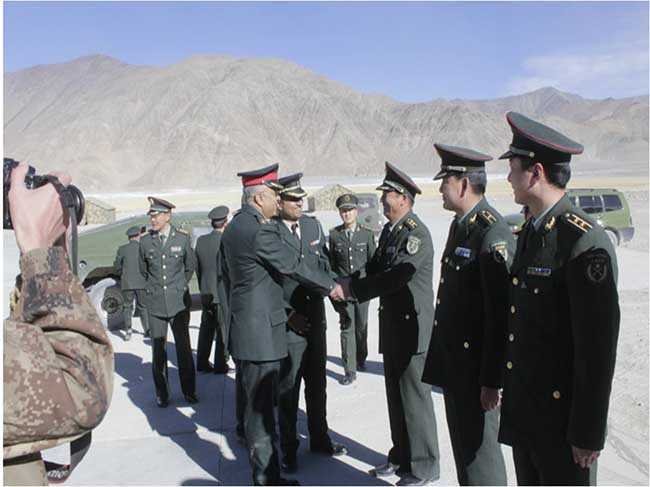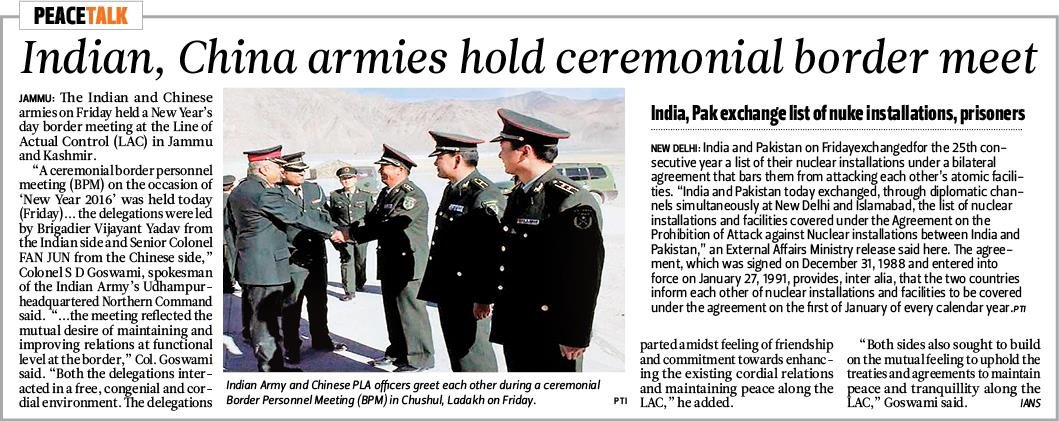Simran Sodhi & Ajay Banerjee,Tribune News Service,New Delhi, January 25
India and France today signed a memorandum of understanding (MoU) on the purchase of the Rafale fighter jets. The much-anticipated inter-governmental agreement (IGA) on Rafale will now be signed later, once the financial negotiations between the two sides are completed.Hectic negotiations had been going on for the past few days to enable the IGA to be signed during French President François Hollande’s visit.At the end of the delegation-level talks between Prime Minister Narendra Modi and Hollande, Modi said only the financial details needed to be worked out in finalising the purchase of Rafale jets from France.“Only financial aspects of the Rafale deal are left. The inter-governmental agreement has been finalised. It will be done soon,” said the Prime Minister. Foreign Secretary S Jaishankar, while briefing the media, later said only the MoU had been signed today and the IGA would be the next step.He said both countries had been able to reach an agreement on the non-financial side, while they were yet to agree on the financial side.The joint statement issued at the end of the delegation-level talks said: “The two leaders welcomed the conclusion of the inter-governmental agreement on the acquisition of 36 Rafale fighter aircraft in flyaway condition, except for some financial issues relating to the IGA which they agreed must be resolved as soon as possible.”India had announced that it would buy 36 Rafale fighters in a government-to-government deal during Modi’s Paris visit in April.Since then, negotiations had been going on about the pricing of the aircraft, the main sticking point in the financial side of the deal. The Tribune had first reported on January 16 that India was looking to go for a better price than take a hasty step at this stage.Sources indicate the cost negotiation committee of the Indian Air Force has met and suggested a price that does not match the expectations of French company Dassault Aviation, the maker of Rafale.The Indian side is doing a cost benefit analysis as it may end up paying nearly Rs 1,200 crore per plane, including arsenal, training and base facilities.In comparison, the last order for 42 Sukhoi-30 MKI fighter jets was agreed upon in 2010 and cost Rs 470 crore per plane. The IAF has told the Ministry of Defence that it needs at least 80 Rafale-type multi-role combat fighter jets to be battle-ready in the next few years.A “mere” 36 jets — presently on order — would not meet the shortfall due to the phasing out of fleet of MiG-21 and MiG-27 jets by 2022.Dassault, in a press release issued, today said: “During French President François Hollande’s visit to India, French and Indian governments signed an inter-governmental agreement paving the way for the conclusion of a contract for the sale of 36 Rafale fighters to India.“Dassault Aviation is very pleased with this progress.”
The cost factor
- IAF’s cost negotiation panel has suggested a price that does not match the expectations of Rafale maker Dassault Aviation, say sources
- At the current price, India may end up paying around Rs 1,200crore per jet, including arsenal, training and base facilities
- During the 2010 Sukhoi-30 MKI jet deal, the fighteraircraft had cost Rs 470 crore each
France, India sign deal for Rafale jets
13 agreements signed in a number of sectors; India to get $10 billion investment in next five years
NEW DELHI: India signed an agreement with France on Monday to buy 36 Rafale fighter jets but said sorting out details of the multibillion euro deal such as pricing and post-sales servicing would take some more time.
PIBPrime Minister Narendra Modi and French President Francois Hollande take a Metro to Gurgaon where they inaugurated the interim secretariat of the International Solar Alliance on Monday.On the second day of French President Francois Hollande visit, the two sides also signed 13 pacts in various fields including railways and civil nuclear energy, with the French promising to invest $10 billion in next five years in India.
“…Leaving out financial aspect, India and France have signed inter-governmental agreement on purchase of 36 Rafale fighter jets. We expect that even the financial aspects… will be resolved as soon as possible,” Prime Minister Modi said at a joint press event with Hollande.
The French President, who will be the chief guest at the Republic Day celebrations on Tuesday, described the deal on Rafale as “a decisive step”.
Modi had announced India’s intention to buy 36 Rafales in Paris in April. Modi and Hollande had to step in after New Delhi scaled back the original plan to buy 126 Rafales and commercial negotiations between planemaker Dassault Aviation and Indian officials collapsed.
Dassault Aviation said on Monday it was supporting French authorities in their efforts to finalise a complete agreement within the next four weeks.
India desperately needs to upgrade its aging Soviet-era fleet plagued by engine troubles and poor availability. The Indian Air Force requires at least 44 fighter squadrons — with 18 planes each — to counter the combined threat from Pakistan and China.
Officials had hoped to seal the deal during Hollande’s visit but resolving the technicalities appeared more complicated than expected, leaving the French President to temper expectations and say such negotiations take time. India was steering clear of setting a deadline to seal the deal as it wanted to get the best price for the fighters, a government official said. HT wrote last week that France had indicated a maximum price of around euro 11.6 billion for the warplanes with full armament complement. India is negotiating to bring the price down to around euro 8 billion.
“What was signed today was an MoU and, when the financial part of it issettled, then obviously the inter-governmental agreement in its entirety will be concluded,” foreign secretary S Jaishankar later told mediapersons.
The agreement, government sources said, would be signed once the prices had been finalised which they hoped would take another four weeks.
The French leader arrived Sunday in Chandigarh, where he was received by Modi. Independent India’s first planned city, Chandigarh was designed by Swiss-French architect Le Corbusier and is one of three places that France has pledged to help develop as smart cities. The other two are Puducherry and Nagpur. France will also help modernise Ambala and Ludhiana railway stations. In a boost to the government’s Make in India campaign, French firm Alstom will manufacture 800 electric locomotives at Madhepura in Bihar.
Hollande said an agreement for France’s Areva to build six nuclear reactors in India should be concluded within a year. The two sides have been wrangling over the price of power from these units for more than a year.
“From nuclear cooperation to railway locomotives, we are sowing the seeds of an ever-tightening web of cooperation between our two countries,” Modi said.
HOLLANDE VISIT
India, France ask Pak to bring Pathankot attackers to justice
Simran Sodhi,Tribune News Service,New Delhi, January 25
India and France today took a significant step forward in addressing the challenges of global terrorism and said there was an “urgent need to establish a comprehensive international legal framework to address the growing global menace of terrorism”. While the recent attacks on Paris and Pathankot found a common resonance in the bilateral discussions, the joint statement clearly called on Pakistan to bring the perpetrators of the recent attacks in Pathankot and Gurdaspur and also the perpetrators of the deadly Mumbai 2008 attacks to justice. “From Paris to Pathankot, we saw the gruesome face of the common challenge of terrorism…I also commend the strength of your resolve… President Hollande and I have agreed to scale up the range of our counter-terrorism cooperation in a manner that helps us to tangibly mitigate and reduce the threat of extremism and terrorism to our societies.“We are also of the view that the global community needs to act decisively against those who provide safe havens to terrorists, who nurture them through finances, training and infrastructure support,” Prime Minister Narendra Modi said at a joint press event with French President Francois Hollande.The joint statement on counter-terrorism issued today said: “Stressing that terrorism cannot be justified under any circumstance, regardless of its motivation, wherever and by whomsoever it is committed, both leaders asked for decisive actions to be taken against Lashkar-e-Toiba, Jaish-e-Mohammad, Hizb-ul-Mujahideen, Haqqani Network and other terrorist groups such as Al-Qaida.”“Condemning the recent terror attacks in Pathankot and Gurdaspur in India, the two countries reiterated their call for Pakistan to bring to justice their perpetrators and the perpetrators of the November 2008 terrorist attacks in Mumbai, which also caused the demise of two French citizens, and to ensure that such attacks do not recur in the future,” it said.The two leaders also strongly condemned the terrorist attacks that occurred in many parts of the world recently and “expressed their shared anguish and outrage at the loss of innocent lives in Paris, Bamako, Beirut, Tunis, San Bernardino, N’Djamena and the Lake Chad Basin Region, Kabul, Gurdaspur, Istanbul, Pathankot, Jalalabad, Jakarta, Ouagadougou and Charsadda.








































































